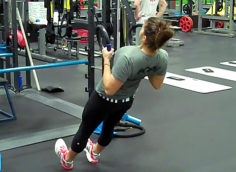More Volume in Less Time
Training volume – the amount of work you do in the gym as measured by exercises, sets, and reps – is key for muscle growth. And if you're looking to maximize training volume in a short amount of time, agonist-antagonist paired-sets may be your new best friends.
Agonist-antagonist sets involve doing a set of an exercise for one muscle or muscle group immediately followed by an exercise working the opposite muscle or muscle group before taking a rest. Think bicep curls paired with tricep extensions, no rest between. Or leg extensions for quads paired with hamstring curls.
This study examines the differences between agonist-antagonist training versus a traditional training routine.
Researchers recruited 15 recreationally trained men with an average of 3.5 years of training experience. After 10RM testing for the wide-grip seated row and bench press, subjects came in for two sessions in randomized order: agonist-antagonist paired-set training or a traditional training routine. Here's how each workout looked:
Agonist-Antagonist Workout
After a warm-up, the lifters did as many reps as possible (AMRAP) at their established 10RM load for bench press followed immediately (10 seconds later) by maximum reps at their established 10RM load on the wide-grip seated row. They then rested two minutes and repeated the pairing three times.
Traditional Workout
After warming-up, the subjects did three sets of AMRAP at their established 10RM load for bench press with two minutes rest between sets. Then they did three sets of AMRAP at their 10RM load for wide-grip seated row with two minutes between sets.
EMG was recorded for the pecs, lats, biceps, and triceps. Volume load for each exercise and workout time was recorded.
Workout time was about half in the paired set group: 8.5 minute average versus 16 minute average. Total volume for the bench and wide grip seated row was higher in the paired-set session compared to the traditional training session. The fatigue index calculated from the EMG (based on greater levels of activation) was greater for pecs, lats, biceps, and triceps during the wide-grip seated row in the paired-set group.
This study shows you can cram more volume into less time using agonist-antagonist sets, at least for bench press and rows, while getting more recovery time between working the same muscle groups.
Rest time between like sets in the paired-set group was about 170 seconds (about 50 seconds more than the traditional sets). This is because of the 10 seconds to switch exercises, the time it took to complete the other exercise, and the given two minute rest. The increased rest time for muscles may be what lead to the increased training volume.
Nonetheless, being able to use agonist-antagonist sets to increase training volume in a shorter amount of time than normal training may be helpful to anyone who has limited training time. And it's an effective workout. Give it a try the next time you're in a time crunch.
- Paz GA et al. Volume load and neuromuscular fatigue during an acute bout of agonist-antagonist paired-set vs. traditional- set training. J Strength Cond Res. 2017 Oct;31(10):2777-2784. PubMed.





